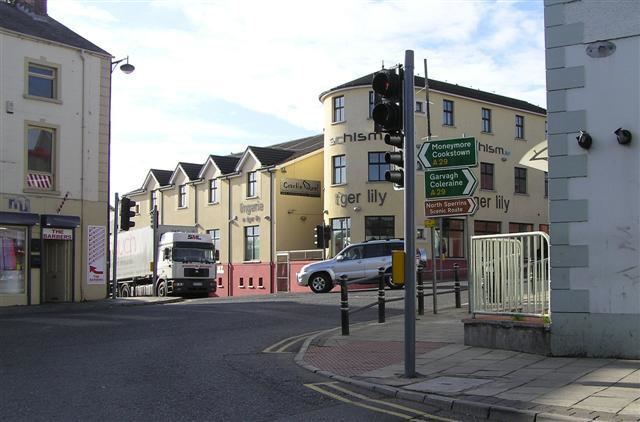Population 3,711 (2001 Census) Post town MAGHERA Province Ulster Dialling code 028 Ni assembly Mid Ulster | Sovereign state United Kingdom Postcode district BT46 Local time Friday 10:21 PM District Mid-Ulster District UK parliament constituency Mid Ulster | |
 | ||
Weather 11°C, Wind W at 19 km/h, 88% Humidity | ||
Maghera (pronounced /ˌmɑːhəˈrɑː/ MAH-hə-RAH, from Irish: Machaire Rátha, meaning "plain of the ringfort") is a town in County Londonderry, Northern Ireland. Its population was 2,876 in 1991 and had risen to 3,711 in the 2001 Census. It is situated within Mid-Ulster District, as well as the civil parish of Maghera, which it was named after, and the former barony of Loughinsholin.
Contents
- Map of Maghera UK
- History
- The Troubles
- Demography
- Places of interest
- Transport
- People from Maghera
- Churches
- Schools
- Primary schools
- Secondary school
- Former secondary school
- Sport
- References
Map of Maghera, UK
History
The Annals of Ulster say that the seat of the Cenél nEoghain was at Ráth Luraig in Maghera.
On 12 July 1830, Orange Order marches led to clashes between Orangemen and Ribbonmen in Maghera and Castledawson. Several Catholic homes were then burnt by Protestants following these clashes.
The Troubles
Maghera suffered significant violence during the Troubles. In total, 14 people were killed, half of them members of the security forces and a further two as a result of family membership of the Ulster Defence Regiment. The Provisional Irish Republican Army were responsible for ten of the deaths.
Demography
Maghera is classified as an intermediate settlement by the NI Statistics and Research Agency (NISRA) (i.e. with population between 2,250 and 4,500 people). On Census day (29 April 2001) there were 3,711 people living in Maghera. Of these:
For more details see: NI Neighbourhood Information Service
Places of interest
Notable buildings in Maghera include St Lurach's Church, which was founded in the year 500AD, originally as a monastery. The town of Maghera grew up around this church. The importance of the monastery was such that Maghera was a bishop's seat in the 12th and 13th centuries. However, the Church was raided by the Vikings and fell into disrepair and is now maintained by the Environmental Heritage Service. Within the ruins, as an inset to the west wall is a sculpture of the crucifixion, which is thought to date from the 10th century – making it one of earliest surviving representations of the crucifixion in Ireland. St Lurach is also the saint of the town.
Transport
Maghera railway station opened on 18 December 1880, shut for passenger traffic on 28 August 1950 and shut altogether on 1 October 1959.
People from Maghera
Churches
In St Patrick's Roman Catholic church there is a headstone remembering the large number of people who died in the parish during the Famine. In the local Church of Ireland parish of St. Lurach's there is a large inscribed bronze plate dedicated to the memory of the local men and women who died in the Great War. The town also has a Presbyterian church.
Schools
There are three primary and one secondary school in Maghera.
